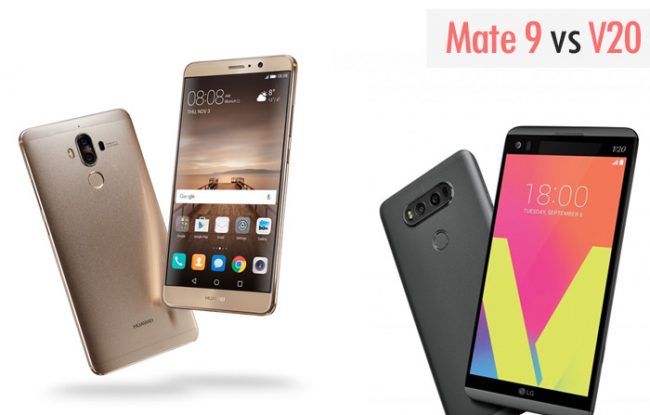Huawei just announced its flagship smartphone – the Mate 9, and it promises to be a flagship killer that’s come just in time for people who are considering on whether to take their business to the Pixel route or just blow up all their money and buy an iPhone 7.
But Huawei has a lot more to consider in competition than just those two phones. The only other phone that comes within similar distance of the Mate 9 in terms of specs is the LG V20. So let’s pit them against each other and see which one comes out on top!
Display
The Mate 9’s display, for a 5.9-inch screen comes in at a resolution of 1080×1920 pixels. Nothing too outstanding here, unfortunately. But it should be enough for those who aren’t going to be doing any VR-based activities with their phone. The V20 on the other hand, has a 5.7-inch 2K display, that’s got quite the reputation for itself. It’s also got a secondary display strip above it, for accessing app shortcuts. Think about the Touch Pad strip on the new MacBooks, but with very limited accessibility options.
The Mate 9’s screen hasn’t been put through its paces yet, but we’re sure it’ll offer some decent quality viewing. Not as high in standard as the V20 will bring in, but close enough. This department’s winner will be the V20.
Performance
The Mate 9 comes with a shiny new custom-made by Huawei – Kirin 960 processor. An Octa-core power house with 4 cores clocked at 2.4 GHz and 4 cores clocked at 1.8 GHz for battery saving. The Mali-G71 MP8 is the GPU of choice, which usually accompanies the Kirins, and they’ve always been proven reliable GPUs, on par, if not more capable than the Adrenos. Memory comes in at 4GB with 64GB of inbuilt capacity and up to 256 GB of external storage available.
A different package altogether, the V20 comes with the Snapdragon 820 quad-core chipset, with 2 cores clocked at 2.15 GHz and the other 2 clocked at 1.6 GHz. The GPU on this beast, is the Adreno 530. The memory and storage options are identical to the Mate 9, with the V20 also coming with a 32GB storage option.
Of course, performance of the devices is based on usage. And the Mate 9 promises to actually become a lot faster the more it is being used, with the software learning and adapting to the user’s usage. On Android, it’s mostly the opposite of what usually happens.
Huawei have completely reskinned their interface, even now offering an app drawer for those who want. It’ll come with Android Nougat out of the box just like the V20. Everyone knows the V20’s UI. It’s flashy, a little goofy looking, but it works. For two phones that currently have one of the best (rather second or third best) internals in their segments, they won’t fail to deliver. Not a lot of phones provide the quality that these boys offer at that cost. So either way, it’ll be a treat for users.
Cameras
Both phones face a stand-off here. They both have dual rear cameras, with the Mate 9 sporting a 20MP + 12MP set up at the back. Special mentioning that Leica is behind the optics this time around, so we can only expect photographs to be on-point and very colour accurate. But the reviews will have the final say in performance.
The V20’s dual camera set up at the rear isn’t any slouch either. It’s got a proven track-record for being one of the best dual-camera phones out there currently. The Mate 9 will have to try a lot to take away the V20’s thunder on this one.
The front facing camera on the Mate will be an 8MP sensor, while the LG’s is a 5MP camera. Both will do well for those medium-lighting selfies at best for the status updates.
The Verdict
The Mate 9 has a much bigger form factor, thanks to its big screen and huge battery – 4000 mAh. The V20’s is only 3200 mAh, but offers a higher res display. But both phones don’t come cheap and will each cross the $700 mark. For those who feel like they can splurge, there’s even a special Porsche edition of the Mate, with a curved display at 2K resolution and 256 GB internal memory that will cost up to $1500 when it becomes available.
Huawei has truly entered the premium segment, placing their Mate 9 over their P series of phones. Although performance and benchmarks are yet to be seen of the phone, we’re sure that the flagship is here to stay.
